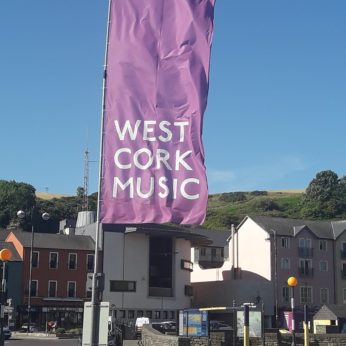Composer: Johannes Brahms (b. 1833 - d. 1897)
Performance date: 04/07/2018
Venue: Bantry Library
Composition Year: 1879
Duration: 00:28:05
Recording Engineer: Tom Norton, RTÉ
Instrumentation: vn, pf
Instrumentation Category:Duo
Artists:
Cédric Tiberghien -
[piano]
Alina Ibragimova -
[violin]

44. CRESPO SERIES – BANTRY HOUSE 15.00
Alina Ibragimova [violin], Cédric Tiberghien [piano]
Johannes Brahms [1833-1897]
Violin Sonata No.1 in G major Op.78 ‘Regensonate’ [1879]
1. Vivace ma non troppo
2. Adagio
3. Allegro molto moderato
Dearest Johannes, I must send you word to tell you how deeply affected I am by your sonata. I received it today and naturally I played through it right away and afterwards, out of joy, I had a really good cry over it. After the first fine, enchanting movement, and the second, you can imagine my delight when in the third, I rediscovered my so ardently beloved melody with its delightful eighth-note rhythm! I say my because I do not believe there is a single person who perceives this melody as joyously and as wistfully as I. After all that wonderful delight, then the last movement as well! My pen is poor, but my heart beats for you in emotion and gratitude, and in spirit I press your hand…..Farewell, dear Johannes. Your faithful Clara.
The G major Sonata was dedicated to Clara Schumann’s son Felix, who was also Brahms’ godson. Felix had died of TB after a long illness earlier in 1879, thus the funeral march in the Adagio. Although this wonderful sonata, one of the greatest masterpieces of the genre, has a sunny and sensuous reputation, the music casts many a shadow as Clara’s emotional reaction to the score suggests.
It’s not worth playing through more than once, and you would have to have a nice, soft rainy evening to give the proper mood, wrote Brahms to his friend Theodor Billroth, when he sent him the score. Not worth playing through more than once is hardly posterity’s view, as Brahms of course knew. His friend quickly figured out the riddle of the nice, soft rainy evening for the motif that dominates the whole work is taken from Brahms’ song Regenlied. This is the melody that so excited Clara, Pour down raindrops; reawaken in me the dreams I dreamed in childhood, is how the song went but the melody itself, with its mood of nostalgia and regret, harked back to Brahms’ and Clara’s shared past.
This radiant sonata was written immediately after the glorious violin concerto, indeed Brahms brought the score to his great friend and musical advisor, the violinist and composer Joseph Joachim, before the proofs of the concerto were completed. Some commentators even feel that the sonata’s slow movement was Brahms’ original idea for the concerto’s slow movement. The dotted rhythm that sets the opening theme in motion pervades the whole work as does the little phrase itself, whose seeming artlessness is of the kind that conceals art. This unifying motif dominates the first movement and reappears in both the other movements and is intimately related to the Regenlied theme. This richly expressive opening leads to an inspired transition passage, where the piano gently reflects on the theme accompanied by the violin’s hushed lower-register double-stopping. Out of this magical atmosphere emerges one of Brahms’ most ecstatic lyrical creations, a glowing second subject that could define beauty. This mood of melodious well-being is soon lost in the development as the music slips into the minor key and passion takes the place of lyricism. However, like Mozart, Brahms could cast shadows without hiding the sun and the music soon returns to the rhapsodic flow of melody.
The E flat Adagio is cast in an extended ABA form, haunted throughout its outer sections by the grim dotted rhythm of a funeral march, while the central section looks at beauty with the saddened eye of experience. The famous and much-loved finale is a surprisingly gentle movement in its evocation of childhood innocence seen across the years-wide gulf of experience. The movement evolves as a rondo, the main episode taking up the Adagio’s second theme and developing it within the context of the rondo’s wandering and obsessive figuration. The coda of the whole work is an even richer synthesis of ideas, scraps of themes from the finale and the adagio are interwoven as the harmony melts back into the long-abandoned G major, the piano textures thin out and the opening theme of the whole work is recalled, its place now clear, and the circle closes on a finally tranquil major-key diminuendo. No wonder Clara was moved to tears.
Francis Humphrys
Copyright © 2025 West Cork Music. All rights reserved.
Designed and developed by Matrix Internet